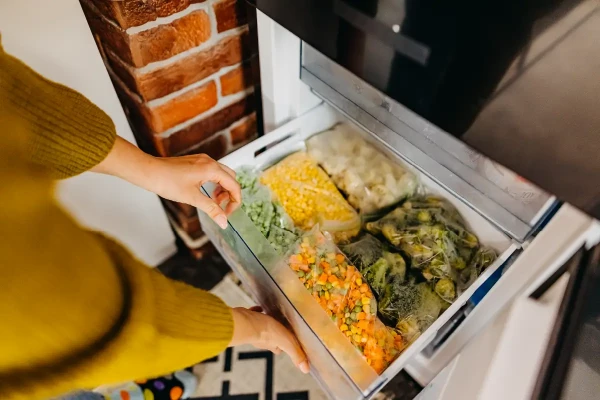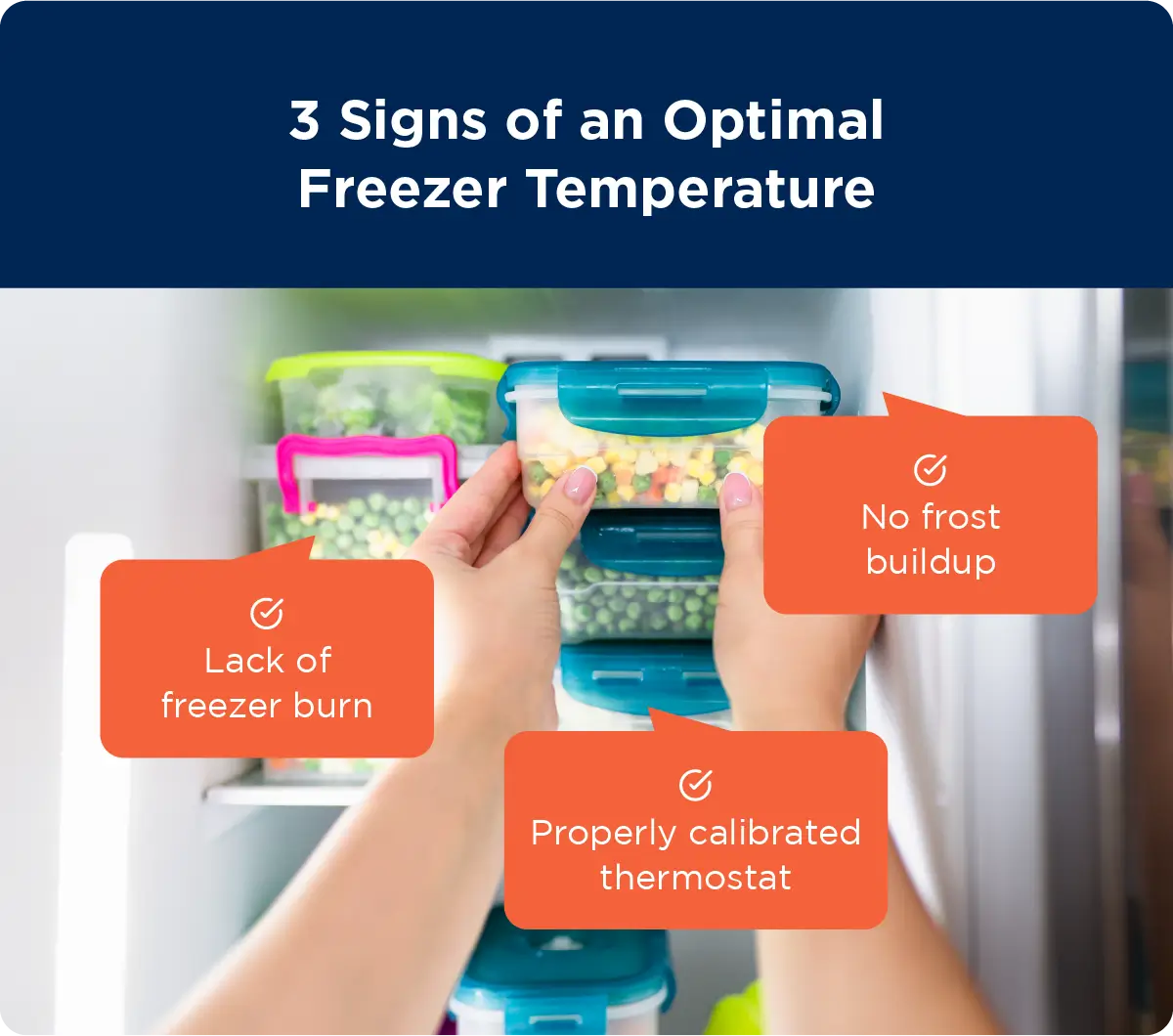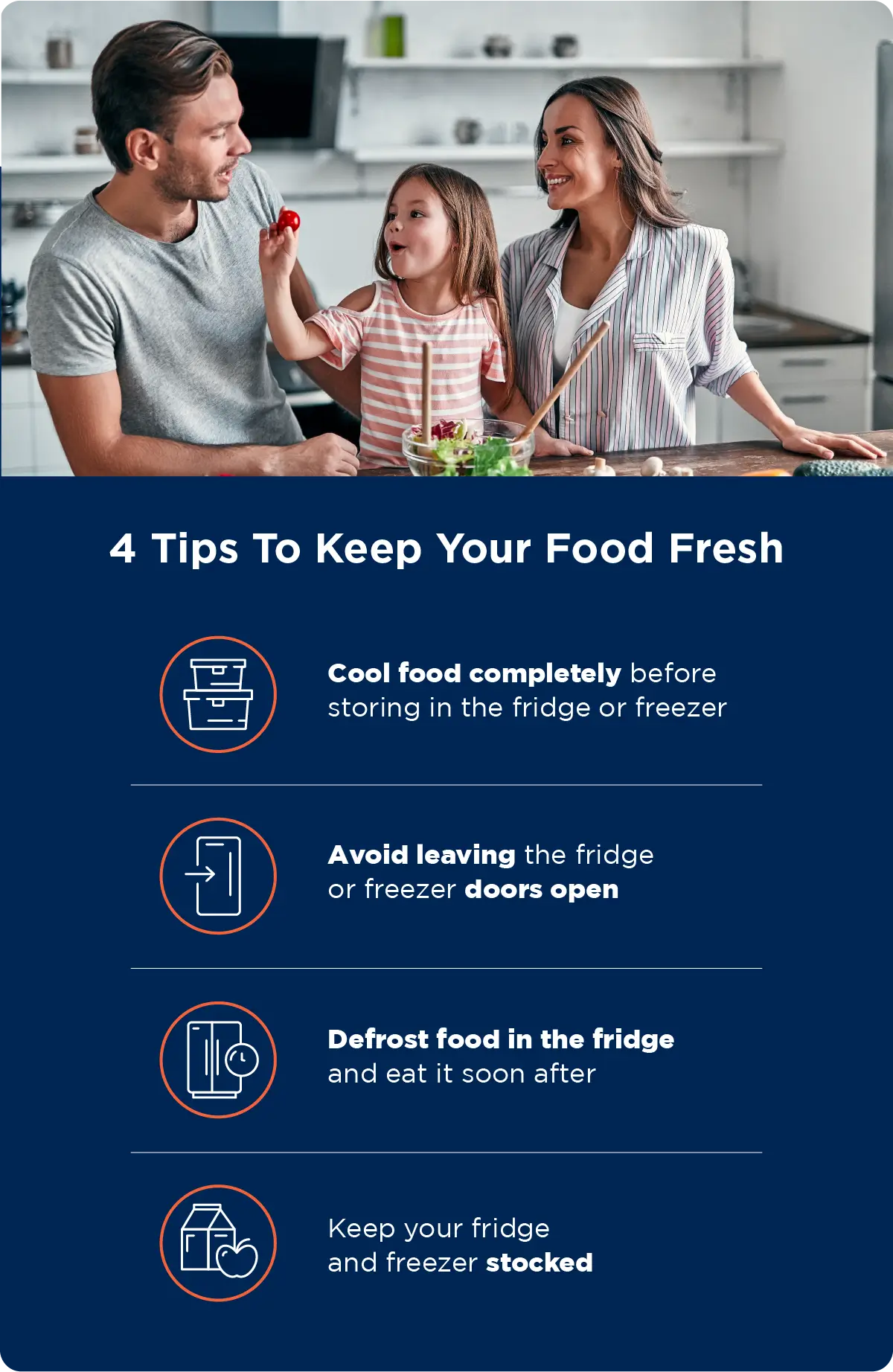What Temperature Should a Freezer Be?

|
The recommended freezer temperature is typically around 0 degrees Fahrenheit (-18 degrees Celsius). This temperature is cold enough to keep food frozen and prevent bacteria growth and spoilage, ensuring your frozen food stays safe and maintains its quality. |
The CDC estimates over 48 million people get sick every year from foodborne illnesses — many of which could have been avoided through proper food storage and handling. Setting the right refrigerator and freezer temperature is essential for food safety and energy efficiency, and achieving the perfect balance is easier than you think.
Ideally, your freezer temperature should be set at 0 degrees Fahrenheit. Maintaining this temperature not only prevents food spoilage but also helps you identify and address issues like frost buildup or temperature fluctuations, ensuring your frozen goods stay in top condition.
In this guide, we'll show you how to set your refrigerator and freezer to their ideal temperatures, how to know if the temperature is set correctly, and how to maintain your appliance long-term.
|
Recommended Temperature |
|
|
Freezer |
Refrigerator |
|
>0℉ |
35℉-38℉ |
What’s the Right Deep Freezer Temperature?
0 degrees Fahrenheit or lower is the ideal deep freezer temperature for most foods. Food items stored at this temperature are safe and can be used indefinitely, although the taste and quality of some items may decrease if stored too long before you use them.
You may be thinking — if food freezes at 32 degrees, why set it at 0 degrees? Setting your freezer to a lower temperature will slow the food’s deterioration process, extending the amount of time it can be stored and used.
What Temperature Should a Refrigerator Be?
The ideal refrigerator temperature range is 35 to 38 degrees Fahrenheit. If the fridge is too cold and items are freezing, adjust the temperature to a higher number.
If you have the option, avoid placing the refrigerator next to the stove, dishwasher, or in direct sunlight. This will keep your refrigerator from running as often, which will reduce energy consumption, but still keep your food and drinks at the ideal temperature. The wrong positioning can make your refrigerator work harder to stay cool.
Other tips to achieve improved fridge energy efficiency include:
- Cleaning the coils regularly to ensure your fridge can dissipate heat effectively
- Checking the door seals around the fridge to ensure they’re clean, free of cracks, and sealed tightly
- Arranging food items strategically to allow for proper air circulation in the fridge
- Referring to the user manual for the best refrigerator temperature for your specific model
If you notice the temperature inside the fridge is inconsistent, it may be time to schedule professional refrigerator repair services with Mr. Appliance®️.
How To Know if Your Freezer Temperature Is Set Correctly

Maintaining the correct temperature in your freezer is essential for preserving the quality and safety of your frozen food. Here are a few key indicators and steps to ensure your freezer is set at the right temperature for energy efficiency and food storage.
1. Lack of Freezer Burn
Freezer burn occurs when food is exposed to air and loses moisture, resulting in dehydration and changes in texture and flavor. It often manifests as dry, discolored patches or crystalline formations on the surface of frozen items. If you find your frozen food consistently plagued by freezer burn, it's a strong indication that your freezer temperature might be too high or that the packaging isn't airtight.
To reset your freezer temperature correctly and avoid freezer burn, start by checking the current temperature with an appliance thermometer. As mentioned earlier, the ideal freezer temperature is around 0 degrees Fahrenheit. If your thermometer reading is significantly higher, adjust the temperature settings accordingly.
2. No Signs of Frost
Another key indicator that your freezer temperature is set correctly is the absence of excessive frost buildup. When you open your freezer and notice a thick layer of frost on the walls, shelves, or stored food, it suggests that the freezer temperature may be too low or that the door seal is compromised, allowing warm, moist air to enter. This frost accumulation not only reduces the available storage space but also forces the freezer to work harder, increasing energy consumption.
To address this issue:
- Regularly check for and remove any excessive frost buildup.
- If it's a recurring problem, confirm that the door seal is intact and replace it if necessary.
- Ensure the freezer is not set at an excessively low temperature, as this can lead to frost formation.
3. Properly Calibrated Thermostats
Checking your freezer’s thermostat is a simple way to confirm it’s set to the right temperature. Most modern freezers have adjustable temperature controls that allow you to set the desired temperature, but every once in a while, they become miscalibrated.
Here’s how to check that your thermostat is operating correctly:
- Consult your freezer's user manual to locate the thermostat control, as its placement can vary between models.
- Once you've identified the control, use a reliable appliance thermometer to measure the internal temperature of the freezer. Again, the ideal temperature range for a standard freezer is approximately 0 degrees Fahrenheit.
- If your thermometer reading does not align with the thermostat, it needs to be adjusted. Follow the instructions provided in your user manual to make the necessary temperature adjustments.
- Allow some time (a few hours or more) for the freezer to stabilize at the new temperature setting, and then recheck with the thermometer.
By routinely monitoring and adjusting the thermostat as needed, you can ensure your freezer maintains the proper temperature for food safety and optimal performance.
How To Keep Food Fresh in Your Fridge and Freezer

Preserving the freshness of the food stored in your fridge and freezer is not only a matter of convenience but is also vital for reducing waste and saving money. By following a few simple yet effective tips, you can extend the shelf life of your groceries and make the most out of your kitchen's cold storage.
1. Allow Your Food To Cool
Letting your food cool completely before placing it in the fridge or freezer is important for both food safety and efficient appliance operation.
Hot food added directly to the fridge or freezer can raise the internal temperature of the appliance, causing other items to partially thaw or warm up. This temperature fluctuation can cause bacteria to grow and compromise the quality of the stored food.
Hot food stored in the refrigerator can also lead to condensation, which increases the humidity inside the appliance. This moisture can affect the texture and taste of the food and may even lead to the development of ice crystals, especially in the freezer, potentially causing freezer burn.
To avoid these issues, it's best to allow your hot dishes or leftovers to cool to room temperature before refrigerating or freezing them. You can use a shallow container to speed up the cooling process and ensure your food remains safe and fresh during storage.
2. Keep the Doors Closed
Refrigeration and freezing rely on maintaining a consistent cold temperature, and any unnecessary warm air infiltration disrupts this delicate balance. Every time the doors are opened, warm air from the room rushes in, causing the appliances to work harder to bring the temperature back down. This extra work not only increases energy consumption but also introduces temperature fluctuations that can compromise the quality and safety of your food.
To minimize these disruptions, make a habit of opening the fridge and freezer doors only when necessary, and try to retrieve all the items you need at once. Be mindful of extended browsing or leaving the doors ajar while cooking.
Additionally, ensure that the door seals (gaskets) are in good condition and are sealed tightly to prevent cold air from escaping and warm air from entering.
3. Defrost and Eat Soon After
During thawing, food becomes more susceptible to bacterial growth — especially when food is thawed at room temperature or left for extended periods in the refrigerator.
To ensure your food is safe to eat, it's best to defrost frozen food in the refrigerator. This method allows for a slow and uniform thaw without exposing the food to harmful temperature variations.
Once thawed, it's important to cook and consume food promptly to minimize the risk of bacterial growth and maintain quality. While some foods may be refrozen after thawing, eating them within a day or two is generally recommended to ensure that they are safe and at their best in terms of taste and texture.
4. Keep a Full Freezer and Fridge
Maintaining a well-stocked fridge and freezer can be beneficial for preserving the freshness of your food.
This is because of thermal mass. A large volume of items can retain and stabilize temperature more effectively. So when your fridge and freezer are relatively full, the items inside act as thermal buffers, helping to maintain a more stable internal temperature.
With less space, there's less room for warm air to infiltrate when the doors are opened, and the cooling system doesn't have to work as hard to counteract temperature fluctuations. This results in less energy consumption and better temperature control.
FAQ About Freezer Temperatures
Whether you're wondering about the ideal freezer temperature, its impact on food safety, or how to troubleshoot temperature-related issues, we've addressed some of the most common queries and concerns below.
Is It OK for Your Freezer To Be Set at 10 Degrees?
Setting your freezer to 10 degrees Fahrenheit is generally not recommended for long-term food storage. Food stored at this temperature is at a higher risk of spoilage and freezer burn, as well as the growth of bacteria and other pathogens.
What Temperature Is Too Low for the Freezer?
While it's essential to keep your freezer sufficiently cold to maintain food safety and quality, extremely low temperatures, typically below -20 degrees Fahrenheit (-29 degrees Celsius), can lead to excessive energy consumption and the risk of items freezing too solidly. Extremely low temperatures can also make it more challenging to maintain the appropriate consistency of certain frozen goods, such as ice cream.
Additionally, if the temperature is too low, some components within your freezer, like the thermostat or compressor, might be forced to work harder, potentially leading to premature wear and tear.
What Is the Best Temperature for Ice Cream?
Ice cream should be stored between -5 and 0 degrees Fahrenheit to maintain its creamy texture and prevent ice crystals from forming.
Where Should I Place Food in my Fridge and Freezer?
When it comes to storing food in your fridge and freezer, proper placement can help maintain freshness, food safety, and efficient cooling. Here are some general guidelines:
Fridge
- Top shelf: Place ready-to-eat foods like leftovers, dairy products, and deli meats on the top shelf.
- Middle shelves: Store items like fruits, vegetables, and beverages on the middle shelves.
- Bottom shelf: Reserve the bottom shelf for raw meat and seafood to prevent any potential cross-contamination. Use a separate container or tray to catch any drips.
- Door: The door shelves are the warmest part of the fridge, so store items with higher acidity, like condiments, there.
Freezer
- Top shelf: Use the top shelf for items you access frequently, such as frozen fruits, vegetables, and frequently used frozen goods.
- Middle shelves: Store items like frozen meat, poultry, and fish on the middle shelves.
- Bottom shelf: Reserve the bottom shelf for items that need longer storage, like prepared meals or items in a deep freeze.
- Door: The freezer door shelves can be less cold and are better suited for items like ice cream or frozen treats.
- Chest freezer: Arrange food in categories, label everything, freeze vertically, and use a “first-in-first-out” method to minimize waste.
What Should I Do if the Power Goes Out?
If the power goes out, it's essential to take certain steps to ensure the safety of your food in both the fridge and freezer.
- Keep the doors closed: Keep the fridge and freezer doors closed as much as possible to retain the cold air. This will help maintain the temperature for a longer time.
- Monitor the temperature: In the case of an extended outage, use a thermometer to monitor the internal temperatures. If the temperature rises above 40 degrees Fahrenheit (4 degrees Celsius) in the refrigerator, you should consider discarding perishable items for safety. If the temperature rises above 0 degrees Fahrenheit (-18 degrees Celsius) in the freezer and the food has thawed, you may need to consume it promptly (within 2-3 days) or cook it and refreeze it if possible.
- Use ice packs or dry ice: Placing ice packs or dry ice in the fridge and freezer can help maintain lower temperatures during the outage. Be sure to follow safety guidelines when using dry ice.
- Group items together: If you know the power will be out for an extended period, try to group items closely together in the freezer. This can help keep the cold contained.
- Plan for perishables: Perishable items like dairy, meat, and leftovers are more susceptible to spoiling. Use or discard these items as soon as possible after an extended power outage.
- Stay informed: Keep an eye on local news or power company updates for information on when the power is expected to be restored.
- Consider a generator: If you experience frequent power outages, investing in a generator can be a good long-term solution to keep your appliances running during outages.
Remember, safety is paramount, and when in doubt, it's best to err on the side of caution and discard any food you suspect may have been compromised during the power outage.
Why Is My Freezer Not Cold Enough?
There are several reasons why your freezer may not be getting cold enough, such as:
- Dirty condenser coils
- Faulty door seals
- Overcrowding
- Frost buildup
- Mechanical issues
- Freezer age, and typical wear and tear
If you’re experiencing temperature issues with your fridge or freezer, contact your local Mr. Appliance for quick troubleshooting and efficient repairs so you can get back to enjoying the heart of your home.
Maintain Your Fridge and Freezer the Right Way
Many homeowners overlook the importance of fridge and freezer temperature maintenance, which can lead to food spoilage, premature appliance problems, and costly replacement. Devoting the proper attention to your essential appliances can help them perform better and last longer.
Contact your local Mr. Appliance for routine maintenance or repairs by scheduling an appointment today.
 Click to call
Click to call


